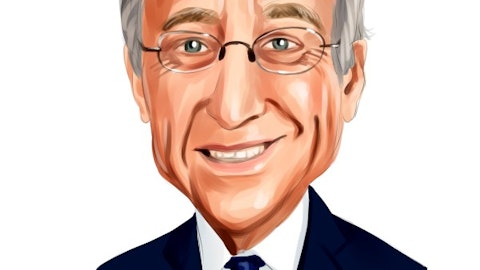Business mix is a big driver of it as you continue to see the shift in our business mix, as we highlighted on page 7, from fundamental equities into some of our lower fee capabilities, including ETFs and index even global liquidity to some extent as well. And within that, as I noted, even within those passive capabilities, you see some business mix pressure just in the most recent couple of quarters with demand for products like the S&P 500 Equal Weight and QQQM as opposed to commodity ETFs, bank loans and some of the other higher fee capabilities that would be within that asset category. So it is business mix among the categories and within the categories. In terms of margins, margins sort of by region are relatively consistent. I think it’s worth noting in China, we’ve often pointed to our margins there, which you can look at and see really as you add back the joint venture there are higher than the firm average.
They are modestly lower now with the implementation of the regulatory mandated fee cuts in China, which we have noted — that — the margins there are still stronger than the firm average and still very attractive, very positive in our positioning there and our growth rate there. We’re very optimistic there. But modestly lower than it would have been previously. And the fourth quarter was our first full quarter of the realization of those fee cuts, which has an overall impact of about $10 million per quarter in revenue.
Ken Worthington: Great. Okay. Thank you very much.
Allison Dukes: Thank you. Ken.
Operator: Thank you. The next question comes from Bill Katz with TD Cowen. Your line is open.
Bill Katz: Okay. Thank you very much for taking the question this morning. Maybe to mix up a little bit. I was wondering if you could just sort of expand a little bit on where you stand with your relationship with Mass Mutual and the opportunity to potentially accelerate growth either into the alternative segment or perhaps even on building out some retail democratization products?
Andrew Schlossberg: Hey, Bill, thanks for the question. Maybe just to refresh everyone’s memory Mass Mutual in addition to owning our comment and being a preferred shareholder, has about $12 billion invested with us across broker-dealer, annuity, sub-advised general account capabilities. One of the most important parts of that has been the $3 billion they have invested into the seating and co-investment of many of our private market strategies, in particular, the ones we’ve been bringing to wealth management over the last several years. And so it’s a very, very important partner in that regard. And that’s a multiple of three times, what we carry on our own balance sheet around those sorts of strategies. So opportunities to continue to develop the relationship there are something we’re focused on, although a lot of that growth has come already.
I think the second area is just taking our relationship further where it makes sense on their insurance platform, with things like our alternative strategies, models, SMAs and ETFs and then select fixed income and equity products. And we’re well placed there, but we’re continuing to look for opportunities and ways to grow effectively. So it’s an important partnership on many levels.
Bill Katz: Maybe just a follow-up on capital. So it sounds like you’re in a much better spot just in terms of reengaging on buyback. Allison, are you expecting to be able to buy back stock in concert with carrying the line of credit? Or do you need to get on the other side of that before you’d restart buyback? And then more broadly, what kind of payout rates should we be thinking about now that your earnings are more diversified and the earnings power is higher?
Allison Dukes: All good questions. And I’d say short answer is, yes, we’d like on the other side of — we’re very committed to getting our net debt down to zero. And that has been a stated goal of ours and something we’ve been working closely in concert with our Board on achieving a stronger balance sheet. And so as we approach that, we look forward to having conversations with the Board and evaluating the opportunity to reengage more regular share buybacks. I think our payout ratio would stay kind of modestly in that 40% to 60% range as it has been in the past. I think that’s a reasonable range for us to operate in as we think about both modestly increasing the common dividend each year as well as buying back stock. But we are a couple of quarters away from where we want to be there, just given the seasonality of cash needs that are before us over the next few months.
We are within sight for the first time in a long time, and we’re really pleased about the progress we’re making with the balance sheet, just the growth in cash and where the debt is heading. So, it does feel like for the first time in a long time, we’re kind of getting back into a position where we can be a lot more opportunistic than we’ve been able to be in the last few years.
Bill Katz: Thank you.
Operator: Thank you. And next question comes from Mike Brown with KBW. Your line is open.
Mike Brown: Great. Thank you for taking my questions. Maybe just a quick follow-up on that last question on capital allocation and — as you get further along on your goals on the balance sheet, do you expect M&A to kind of come back into the equation not necessarily large M&A, but perhaps maybe more on the bolt-on side as you think about adding capabilities and perhaps altering the strategic asset mix as you start to look out to, say, 2025?




